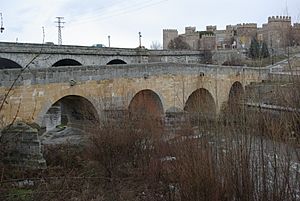Roman bridge of Ávila facts for kids
The Roman bridge of Ávila (in Spanish: Puente Romano de Ávila) is a bridge in Ávila, Spain. Some parts of the bridge are very old, built by the Romans. Today, it is a special historic place.
It crosses the Adaja River. Long ago, it was an important path to the main street inside Ávila's old city walls. The first parts were built around 1 AD. The strong supports (called piers) at the bottom, with their pointy ends (starlings) that help the water flow, are still from Roman times. The rest of the bridge was rebuilt later, in the 11th and 13th centuries, in a style called Romanesque.
What the Bridge Looks Like
The bridge has five arches and four strong supports (piers). These piers have special pointy parts (starlings) that look like a boat's front. These parts help the bridge stand strong against the river's current. The bridge also has parts that stick out on the other side of the piers. The western end of the bridge, called the abutment, is still there.
The top of the bridge is mostly flat on the eastern side. The western side slopes down a bit. The arches start at different heights but usually reach the same top level. However, the largest arch, which was completely rebuilt, appears a little lower.
History of the Bridge
At some point, the bridge was damaged on purpose. The biggest arch was destroyed, and other parts were cut. You can still see these cuts today. It is possible this damage happened around 711 AD, during the Arab invasion. It might also have happened later, during the Reconquista. At that time, armies might have damaged the bridge to stop their enemies or to block their retreat, especially when the river was high.
When people started living in Ávila again in the 11th century, the bridge was rebuilt. It was built on its strong Roman granite pillars. For the new parts, sandstone from La Colilla was used. This stone was common in Ávila's Romanesque churches. However, it was not very strong against wear and tear.
In the 13th century, the bridge was repaired again. The granite rocks at the top, with a rounded wall (parapet), are likely from this time. This style is similar to other bridges in the area, like the Santi Espiritu and Romanillos bridges on the Chico River.
See also
 In Spanish: Puente romano de Ávila para niños
In Spanish: Puente romano de Ávila para niños


